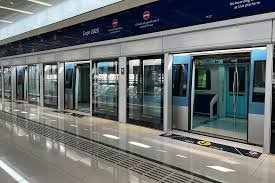Dubai’s ultra-modern public transportation system is not just a network of convenience—it’s a reflection of the city’s strategic branding, rich history, and bold planning. One of the most fascinating facts about the Dubai Metro is that not all station names are up for grabs. Yes, you heard that right. While many stations have changed names over the years through corporate sponsorships, some stations are forever fixed—by design, tradition, or sheer necessity.
Let’s take a closer look at why some Dubai Metro stations cannot be renamed, the stories behind their names, and what it means for the city’s residents and travelers.
Branding Meets Navigation: Why Names Matter
Dubai Metro, operated by the Roads and Transport Authority (RTA), has become a benchmark for efficient, clean, and futuristic urban transport. Since its launch in 2009, the Metro has become an essential part of daily life for millions of commuters.

To fund this monumental project, RTA implemented a unique corporate naming rights model, allowing companies to sponsor metro stations in exchange for brand visibility. This has led to iconic names like BurJuman, Onpassive, and Equiti—brands that resonate with residents and tourists alike.
But not all names are negotiable. Some station names are off-limits for rebranding, either because of cultural relevance, geographical identifiers, or strategic significance.
📍 RTA official site: https://www.rta.ae

Which Metro Station Names Can’t Be Changed?
While most stations can be renamed if a deal is struck, there are a handful of names that are deemed “static”—unchangeable regardless of sponsorship offers. These names are preserved for historical, geographic, or policy-related reasons. Here are some of them:
1. Union Station
One of the largest and oldest interchanges in the entire Metro system, Union Station is more than just a transfer point—it’s a symbol of unity. Located in Deira, it connects the Red and Green lines, acting as a major hub for passengers moving across the city.
The name “Union” represents national significance and ties back to the UAE’s founding principles. Because of its political and emotional weight, RTA has declared that the name will remain unchanged.
2. Al Ghubaiba
Serving as a historical gateway to Old Dubai, Al Ghubaiba is deeply rooted in the city’s heritage. It’s one of the key stations that cater to the creekside neighborhoods and has close ties to the old souks, abra stations, and traditional trading routes.
This station is considered a heritage name, and due to its deep cultural associations, RTA has made it off-limits for corporate rebranding.
3. Airport Terminal 1, 2, and 3
It goes without saying that stations directly linked to Dubai International Airport (DXB) hold essential geographical identifiers. Airport Terminal stations are used not just by residents, but also by thousands of international travelers every day.
These names are functional, essential for navigation, and protected by policy to avoid confusion and maintain clarity for tourists and locals alike.
4. Burj Khalifa/Dubai Mall
One of the most famous stations in the world, this stop leads directly to two of Dubai’s greatest attractions: Burj Khalifa and The Dubai Mall. While it’s technically possible that part of the name could be up for branding, the “Burj Khalifa” portion is non-negotiable, given its status as the world’s tallest building and a global icon.
5. Dubai Healthcare City
This station is located in a specialized medical zone, home to hospitals, clinics, and medical universities. Because of its designated zone status and association with Dubai’s healthcare initiatives, the name has institutional significance and is unlikely to be altered.
6. Jumeirah Lakes Towers (JLT)
While not officially declared non-changeable by the RTA, industry experts say that stations named after entire communities or geographic zones like JLT are very unlikely to change, simply because these names are used as key references for residents and businesses in the area.
The Bigger Picture: Why Station Naming Is Strategic
The idea of selling naming rights was not just about generating revenue—it was a bold, strategic move. Dubai’s approach to urban branding is admired worldwide. With over 40 stations on the Red and Green lines, naming rights became a valuable asset for companies looking to associate their brands with Dubai’s innovation.
According to the RTA, naming rights deals last 10 years, and sponsors must go through a rigorous process before a name is approved. Factors include cultural relevance, public convenience, and brand fit. Yet, even with the allure of branding, some names are just too important to be touched.

A Name That Guides and Grounds
For locals, the fixed names serve as navigation anchors, helping them easily move around the city. For tourists, these names reflect the real identity of Dubai, beyond the glitter and glamour. From Union’s symbolic depth to Al Ghubaiba’s cultural richness, these metro stops tell stories—of a city that honors its past while racing toward the future.
And as Dubai continues to expand its Metro with new lines and stations, the balance between commercial branding and cultural preservation will remain key.
Final Thoughts
Station names might seem like simple signposts, but in Dubai, they’re carefully curated pieces of a larger narrative—a narrative of progress, pride, and identity. While brands may come and go, some names stand tall as permanent fixtures in the city’s heart and soul.
So next time you hop onto a metro in Dubai, look up at the sign. That name might not just be a direction—it might be a legacy.
📍 For full station listings and updates: https://www.rta.ae
Also read: Dubai Chamber Hosts Gulf Business Leaders Forum to Boost Investment













